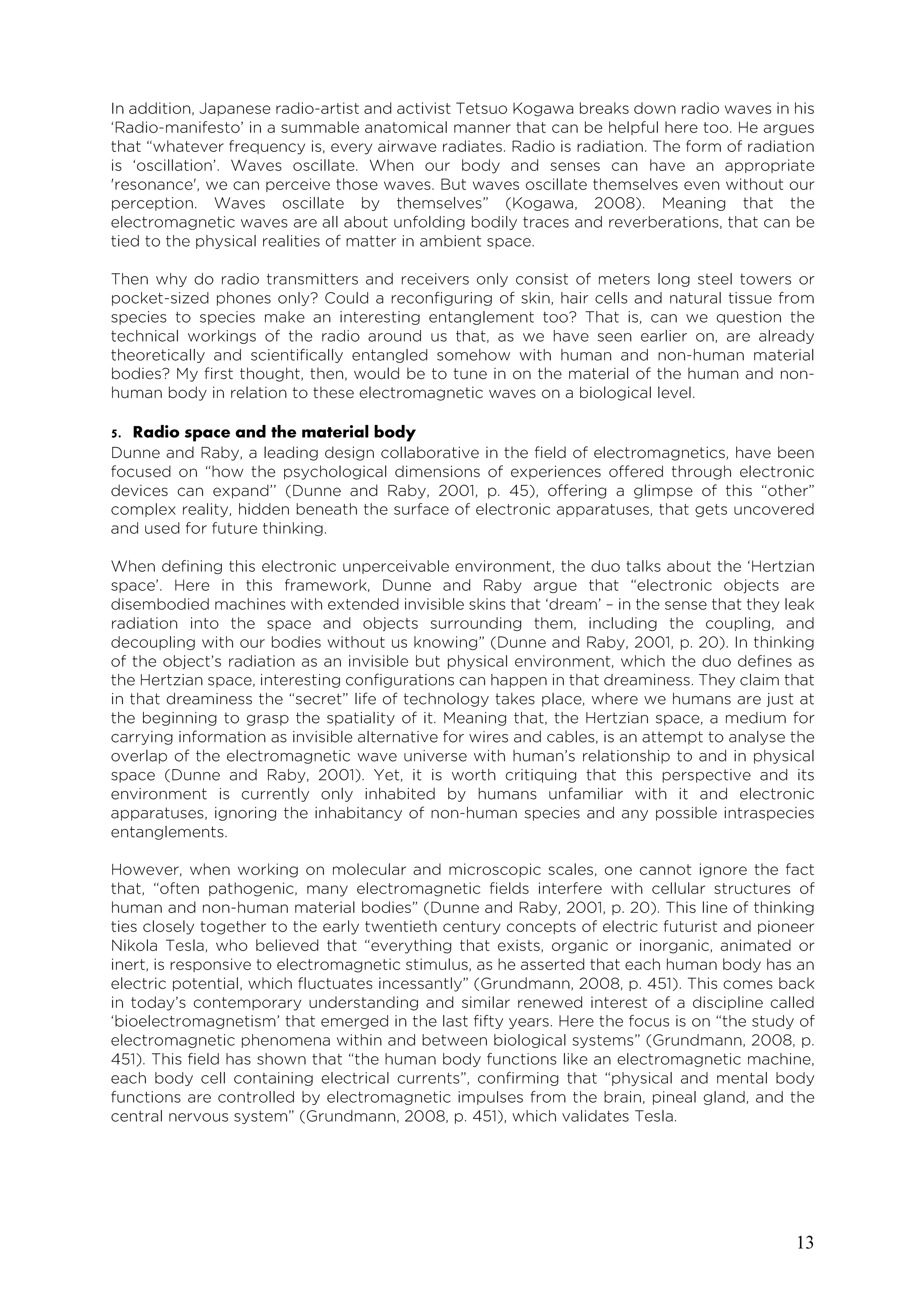Radio Umwelt: How to become an intraspecies radio, master graduation thesis (2022, Piet-Zwart Institute)
What: Academic writing, literary research, expert relations, publication editing, book design, programming and electrical prototyping.
Role: Writer, researcher, collaborator, designer.
A multidisciplinary research and juxtaposition of various sources and fields (architecture, philosophy, quantum-mechanics, physics and biology), that theorizes on a model for intra-species communication that uses radio waves as a technological tool and space that mediates species’ perceptual boundary limitation. Herein, I’m proposing a radio space to critically be re-thought within the field of spatial design and architecture, by engaging with radio technology to argue for an alternative model of conceptualizing a non-anthropocentric world. A world that is focused on the sound that is made through radio and the spaces that radio waves occupy, opening up new notions of space and potential for its speculative theorization.
The thesis’ inquiry departs from a foundational reading of Jacob von Uexküll’s notion of Umwelt theory and its criticality of anthropocentric understanding of perception. His theory is combined with feminist theorist Karen Barad’s notion of entanglement and agential realism, making use of the claim that interacting beings are ontologically inseparable. Herein, I’m posing a potent question on the mutual perception of species and the possible role of technology in this process. The thesis argues that electromagnetic waves enable the human perception of intra-action between various human and non-human agents, while, following Barad, demonstrates that technological apparatuses, and the radio space itself, should considered an intra-acting phenomena, too. Furthermore, I’m introducing the urgent political aspect of the radio space, its governmental control over its ownership, commercialisation and militarisation, before proposing a subversion of this space that ignores any human non-human separation. Through exploring radio frequencies as a model to conceptualize moving beyond perceptual boundaries, it arrives to a theorization of the notion of listening that builds on the decolonial work of Rolando Vazquez. Concluding that listening to radio waves as an act of intra-active being/becoming or as our ethical responsibility to move toward the material world and make ourselves able to perceive and respond to its overtures, can be the extended subjectivity we humans need here. To relate differently without having to sort what is already “known” but recognize what is unknown and unperceivable.
During the exhibition of my research and design project, I displayed two important maps that broadly support my writing. The colorful map is one that indicates the pressing political aspect of commercialization, militarization and ownership of radio space. It shows how humans claim and sell the radio landscape as real estate right down to the last frequency range. The second map is the one representing a subversion of this space that ignores any human non-human separation by ownership or power. It shows the encoded radio landscape as a raw receptive space in which intra-action between human and nonhuman entangled material bodies is received and continuously transmitted back into the ether again.
A map that knows no boundaries or separation between species, but shows only the radio landscape and its inhabitants as intertwined and inseparable. As a result of this, I made an animation that emphasized the spatial relationship and speculation of world that is focused on the sound that is made through radio and the spaces that radio waves and its bodies occupy:
In collaboration with the printed maps of the radio landscape as claimed or as subversive, I wanted to incorporate the thesis text in the installation as well. That’s why for the printed and published version of my thesis, I wanted to provide an experience for visitors that explains in an easy way how the radio landscape and radio waves behave around us, how we affect them and how we are affected by them. Therefore, I set out to see how I could make electromagnetic waves perceivable using my text as a source, or more specifically as a radio wave.
The end result is a book that consists of a usual front and back cover but instead of a binding cover in-between, the sides are connected with just the printed semi-transparent pages that are zigzagged together. The front and back covers consist of several layers of Plexiglas attached with book screws, providing a laser-cut out space for the hardware that the book carries. Which is, a radio transmitter incorporated into the front of the book and a radio receiver into the back. Visitors can open the semi-transparent/semi-observable object and interactively turn on the transmitter. A soundboard then plays a sound fragment; my entire thesis text as an encoded radio signal. These waves can be received by the back of the book if the visitor manages to find the correct frequency at which the signal is broadcasted in the radio space.
When browsing through the text combined with the presence of electrically charged material bodies in the space around the book, the signal and thus the text after which the receiver receives a different text. This symbolizes the information contained in these waves and the radio space in which one can conclude that we are all contributors in that space as intra-active material bodies but that space contributes intra-actively to all those bodies too. We just have to find ways to make this information observable.
Here you can listen to the pre-recorded audio that is the encoded thesis text as radio signal:





















































